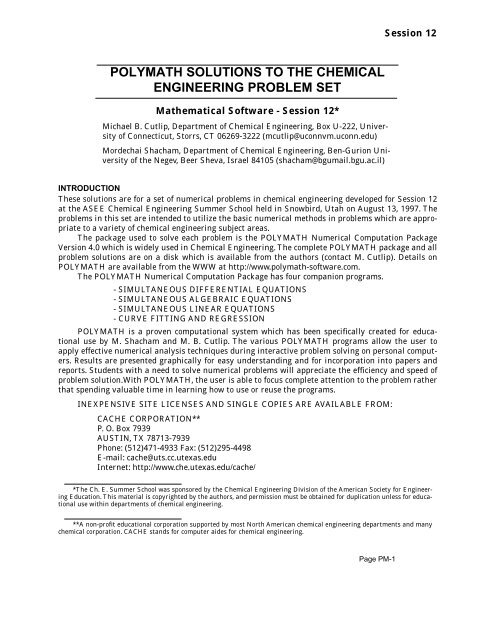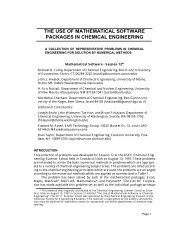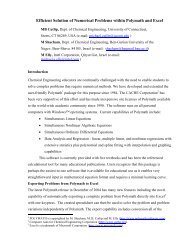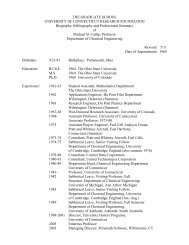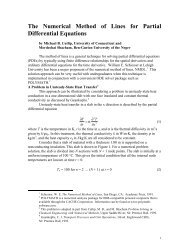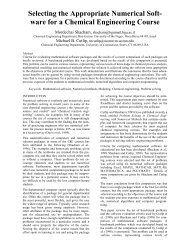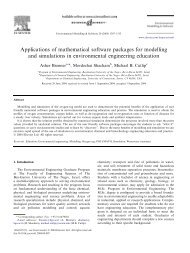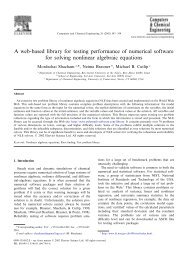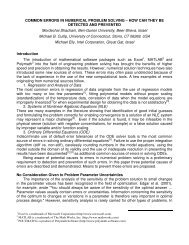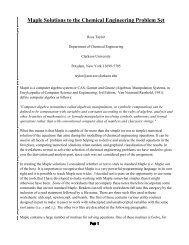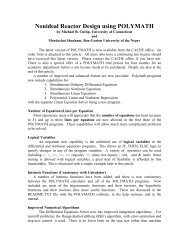polymath solutions to the chemical engineering problem set
polymath solutions to the chemical engineering problem set
polymath solutions to the chemical engineering problem set
Create successful ePaper yourself
Turn your PDF publications into a flip-book with our unique Google optimized e-Paper software.
POLYMATH SOLUTIONS TO THE CHEMICAL<br />
ENGINEERING PROBLEM SET<br />
Ma<strong>the</strong>matical Software - Session 12*<br />
Michael B. Cutlip, Department of Chemical Engineering, Box U-222, University<br />
of Connecticut, S<strong>to</strong>rrs, CT 06269-3222 (mcutlip@uconnvm.uconn.edu)<br />
Mordechai Shacham, Department of Chemical Engineering, Ben-Gurion University<br />
of <strong>the</strong> Negev, Beer Sheva, Israel 84105 (shacham@bgumail.bgu.ac.il)<br />
INTRODUCTION<br />
These <strong>solutions</strong> are for a <strong>set</strong> of numerical <strong>problem</strong>s in <strong>chemical</strong> <strong>engineering</strong> developed for Session 12<br />
at <strong>the</strong> ASEE Chemical Engineering Summer School held in Snowbird, Utah on August 13, 1997. The<br />
<strong>problem</strong>s in this <strong>set</strong> are intended <strong>to</strong> utilize <strong>the</strong> basic numerical methods in <strong>problem</strong>s which are appropriate<br />
<strong>to</strong> a variety of <strong>chemical</strong> <strong>engineering</strong> subject areas.<br />
The package used <strong>to</strong> solve each <strong>problem</strong> is <strong>the</strong> POLYMATH Numerical Computation Package<br />
Version 4.0 which is widely used in Chemical Engineering. The complete POLYMATH package and all<br />
<strong>problem</strong> <strong>solutions</strong> are on a disk which is available from <strong>the</strong> authors (contact M. Cutlip). Details on<br />
POLYMATH are available from <strong>the</strong> WWW at http://www.<strong>polymath</strong>-software.com.<br />
The POLYMATH Numerical Computation Package has four companion programs.<br />
- SIMULTANEOUS DIFFERENTIAL EQUATIONS<br />
- SIMULTANEOUS ALGEBRAIC EQUATIONS<br />
- SIMULTANEOUS LINEAR EQUATIONS<br />
- CURVE FITTING AND REGRESSION<br />
POLYMATH is a proven computational system which has been specifically created for educational<br />
use by M. Shacham and M. B. Cutlip. The various POLYMATH programs allow <strong>the</strong> user <strong>to</strong><br />
apply effective numerical analysis techniques during interactive <strong>problem</strong> solving on personal computers.<br />
Results are presented graphically for easy understanding and for incorporation in<strong>to</strong> papers and<br />
reports. Students with a need <strong>to</strong> solve numerical <strong>problem</strong>s will appreciate <strong>the</strong> efficiency and speed of<br />
<strong>problem</strong> solution.With POLYMATH, <strong>the</strong> user is able <strong>to</strong> focus complete attention <strong>to</strong> <strong>the</strong> <strong>problem</strong> ra<strong>the</strong>r<br />
that spending valuable time in learning how <strong>to</strong> use or reuse <strong>the</strong> programs.<br />
INEXPENSIVE SITE LICENSES AND SINGLE COPIES ARE AVAILABLE FROM:<br />
CACHE CORPORATION**<br />
P. O. Box 7939<br />
AUSTIN, TX 78713-7939<br />
Phone: (512)471-4933 Fax: (512)295-4498<br />
E-mail: cache@uts.cc.utexas.edu<br />
Internet: http://www.che.utexas.edu/cache/<br />
*The Ch. E. Summer School was sponsored by <strong>the</strong> Chemical Engineering Division of <strong>the</strong> American Society for Engineering<br />
Education. This material is copyrighted by <strong>the</strong> authors, and permission must be obtained for duplication unless for educational<br />
use within departments of <strong>chemical</strong> <strong>engineering</strong>.<br />
**A non-profit educational corporation supported by most North American <strong>chemical</strong> <strong>engineering</strong> departments and many<br />
<strong>chemical</strong> corporation. CACHE stands for computer aides for <strong>chemical</strong> <strong>engineering</strong>.<br />
Page PM-1<br />
Session 12
Page PM-2 MATHEMATICAL SOFTWARE PACKAGES IN CHEMICAL ENGINEERING<br />
Polymath Problem 1 Solution<br />
Equation (1) can not be rearranged in<strong>to</strong> a form where V can be explicitly expressed as a function of T<br />
and P. However, it can easily be solved numerically using techniques for nonlinear equations. In order<br />
<strong>to</strong> solve Equation (1) using <strong>the</strong> POLYMATH Simultaneous Algebraic Equation Solver, it must be<br />
rewritten in <strong>the</strong> form<br />
PM-(1)<br />
where <strong>the</strong> solution is obtained when <strong>the</strong> function is close <strong>to</strong> zero, f( V)<br />
≈<br />
0 . Additional explicit equations<br />
and data can be entered in<strong>to</strong> <strong>the</strong> POLYMATH program in direct algebraic form. The POLY-<br />
MATH program will reorder <strong>the</strong>se equations as necessary in order <strong>to</strong> allow sequential calculation.<br />
The POLYMATH equation <strong>set</strong> for this <strong>problem</strong> are given by<br />
Equations:<br />
f(V)=(P+a/(V^2))*(V-b)-R*T<br />
P=56<br />
R=0.08206<br />
T=450<br />
Tc=405.5<br />
Pc=111.3<br />
Pr=P/Pc<br />
a=27*(R^2*Tc^2/Pc)/64<br />
b=R*Tc/(8*Pc)<br />
Z=P*V/(R*T)<br />
Search Range:<br />
V(min)=0.4, V(max)=1<br />
In order <strong>to</strong> solve a single nonlinear equation with POLYMATH, an interval for <strong>the</strong> expected solution<br />
variable,V in this case, must be entered in<strong>to</strong> <strong>the</strong> program. This interval can usually be found by<br />
consideration of <strong>the</strong> physical nature of <strong>the</strong> <strong>problem</strong>.<br />
(a) For part (a) of this <strong>problem</strong>, <strong>the</strong> volume calculated from <strong>the</strong> ideal gas law as V = 0.66 liter/gmol<br />
can be a basis for specifying <strong>the</strong> required solution interval. An interval for <strong>the</strong> expected solution<br />
for V can be entered as between 0.4 as <strong>the</strong> lower limit and 1.0 as <strong>the</strong> higher limit. The POLYMATH<br />
solution, which is given in Figure PM-(1) for T = 450 K and P = 56 atm, yields V = 0.5749 liter/gmol<br />
where <strong>the</strong> compressibility fac<strong>to</strong>r is Z = 0.8718.<br />
(b) Solution for <strong>the</strong> additional pressure values can be accomplished by changing <strong>the</strong> equations<br />
in <strong>the</strong> POLYMATH program for P and Pr<br />
<strong>to</strong><br />
Pr=1<br />
P=Pr*Pc<br />
a<br />
f( V)<br />
P<br />
V 2<br />
= ⎛ +<br />
⎝<br />
------ ⎞( V – b)<br />
– RT<br />
⎠<br />
Additionally, <strong>the</strong> bounds on <strong>the</strong> molar volume V may need <strong>to</strong> be altered <strong>to</strong> obtain an interval where<br />
<strong>the</strong>re is a solution. Subsequent program execution for <strong>the</strong> various Pr’s<br />
is required.<br />
(c) The calculated molar volumes and compressibility fac<strong>to</strong>rs are summarized in Table (1).<br />
These calculated results indicate that <strong>the</strong>re is a minimum in <strong>the</strong> compressibility fac<strong>to</strong>r Z at approximately<br />
Pr<br />
= 2. The compressibility fac<strong>to</strong>r <strong>the</strong>n starts <strong>to</strong> increase and reaches Z = 2.783 for Pr<br />
= 20 .
Polymath Problem 1 Solution Page PM-3<br />
f(V)<br />
Figure PM-1 Plot of f(V) versus V for van der Waals Equation<br />
Table PM-1<br />
P(atm)<br />
Compressibility Fac<strong>to</strong>r for Gaseous Ammonia at 450 K<br />
P<br />
r<br />
V Z<br />
56 0.503 .574892 0.871827<br />
111.3 1.0 .233509 0.703808<br />
222.6 2.0 .0772676 0.465777<br />
445.2 4.0 .0606543 0.731261<br />
1113.0 10.0 .0508753 1.53341<br />
2226.0 20.0 .046175 2.78348<br />
Variable Value f( )<br />
V 0.574892 0<br />
P 56<br />
R 0.08206<br />
T 450<br />
Tc 405.5<br />
Pc 111.3<br />
Pr 0.503145<br />
a 4.19695<br />
b 0.03737712<br />
Z 0.871827
Page PM-4<br />
MATHEMATICAL SOFTWARE PACKAGES IN CHEMICAL ENGINEERING<br />
Polymath Problem 2 Solution<br />
(a) The coefficients and <strong>the</strong> constants in <strong>the</strong> Equation Set Equation (6) can be directly introduced<br />
in<strong>to</strong> <strong>the</strong> POLYMATH Linear Equation Solver in matrix form as shown<br />
The solution is<br />
Name x1 x2 x3 x4 b<br />
1 0.07 0.18 0.15 0.24 10.5<br />
2 0.04 0.24 0.1 0.65 17.5<br />
3 0.54 0.42 0.54 0.1 28<br />
4 0.35 0.16 0.21 0.01 14<br />
Variable Value<br />
which corresponds <strong>to</strong> <strong>the</strong> unknown flow rates of D1<br />
min, and B2<br />
= 17.5 mol/min.<br />
x1 26.25<br />
x2 17.5<br />
x3 8.75<br />
x4 17.5<br />
= 26.25 mol/min, B1<br />
= 17.5 mol/min, D2<br />
= 8.75 mol/<br />
(b) The overall balances and individual component balances on column #2 given in Equation Set<br />
(7) can be solved algebraically <strong>to</strong> give XDx<br />
= 0.114, XDs<br />
= 0.120, XDt<br />
= 0.492 and XDb<br />
= 0.274. Similarly,<br />
overall balance and individual component balances on column #3 presented as Equation Set (8) yield<br />
XBx<br />
= 0.210, XBs<br />
= 0.4667, XBt<br />
= 0.2467 and XBb<br />
= 0.0767.
Polymath Problem 3 Solution Page PM-5<br />
Polymath Problem 3 Solution<br />
(a) Data Regression with a Polynomial The POLYMATH Polynomial, Multiple Linear and<br />
Nonlinear Regression Program can be used <strong>to</strong> solve this <strong>problem</strong> by first entering <strong>the</strong> data in a similar<br />
manner <strong>to</strong> using a spreadsheet. Let us denote <strong>the</strong> column of temperature data in °C as TC and <strong>the</strong> column<br />
of pressure data as P.<br />
This POLYMATH worksheet is reproduced in Figure PM-(2) where <strong>the</strong><br />
first two columns are used in <strong>the</strong> polynomial regressions.<br />
Figure PM-2 POLYMATH Entry for Regressions<br />
A polynomial regression option within POLYMATH when <strong>the</strong> dependent variable column titled<br />
P is regressed with <strong>the</strong> independent variable TC corresponds directly <strong>to</strong> Equation (9). The results are<br />
summarized in Figure PM-(3) which also presents <strong>the</strong> value of <strong>the</strong> variance (var,) for each polynomial.<br />
The variance indicates that <strong>the</strong> polynomial which best represents <strong>the</strong> data in this case is <strong>the</strong> 4th<br />
degree.<br />
(b) Regression with Clausius-Clapeyron Equation Data regression with <strong>the</strong> Clausius-Clapeyron<br />
expression, Equation (10), can be accomplished by three additional transformed variables (columns)<br />
in <strong>the</strong> POLYMATH program used for part (a). Columns can be defined by <strong>the</strong> relationships:<br />
logP = log(P), TK= T + 273.15, and neginvTK = -1/TK as indicated in Figure PM-(2). A request for linear<br />
regression when <strong>the</strong> first (and only) independent variable column is neginvTK and <strong>the</strong> dependent<br />
variable column is logP yields <strong>the</strong> following plot and numerical results from POLYMATH as shown in<br />
Figure PM-(4).<br />
(c) Regression with <strong>the</strong> An<strong>to</strong>ine Equation This expression, Equation (11), cannot be linearized<br />
and so it must be regressed with nonlinear regression option of <strong>the</strong> POLYMATH Polynomial, Multiple<br />
Linear and Nonlinear Regression Program.<br />
With this option, <strong>the</strong> user must supply initial estimates.<br />
In this case, it is helpful <strong>to</strong> use <strong>the</strong> initial estimates for A and B which were determined in part (b)<br />
and use <strong>the</strong> estimate for C as 273.15. Direct entry of Equation (11) with <strong>the</strong> initial estimates gives <strong>the</strong><br />
converged results shown in Figure PM-(5).
Page PM-6<br />
MATHEMATICAL SOFTWARE PACKAGES IN CHEMICAL ENGINEERING<br />
Figure PM-3 POLYMATH Results for Fitting Polynomials <strong>to</strong> Vapor Pressure Data<br />
Parameter Value<br />
0.95 Conf<br />
Interval<br />
A 8.75201 0.542335<br />
B 2035.33 153.628<br />
Var 0.00759156<br />
Figure PM-4 POLYMATH Results for Regression of Clausius-Clapeyron Equation
Polymath Problem 3 Solution Page PM-7<br />
Figure PM-5 POLYMATH Results for Nonlinear Regression of An<strong>to</strong>ine Equation
Page PM-8<br />
MATHEMATICAL SOFTWARE PACKAGES IN CHEMICAL ENGINEERING<br />
Polymath Problem 4 Solution<br />
The Equation Set (13) can be entered in<strong>to</strong> <strong>the</strong> POLYMATH Simultaneous Algebraic Equation Solver,<br />
but <strong>the</strong> nonlinear equilibrium expressions must be written as functions which are equal <strong>to</strong> zero at <strong>the</strong><br />
solution. A simple transformation of <strong>the</strong> equilibrium expressions of Equation Set Equation (12) <strong>to</strong> <strong>the</strong><br />
required functional form yields<br />
PM-(2)<br />
The above equation <strong>set</strong> may be difficult <strong>to</strong> solve because <strong>the</strong> division by unknowns may make most<br />
solution algorithms diverge.<br />
Expediting <strong>the</strong> Solution of Nonlinear Equations<br />
An additional simple transformation of <strong>the</strong> nonlinear function can make many functions much less<br />
nonlinear and easier <strong>to</strong> solve by simply eliminating division by <strong>the</strong> unknowns. In this case, <strong>the</strong> Equation<br />
Set PM-(2) can be modified <strong>to</strong><br />
PM-(3)<br />
The POLYMATH equation <strong>set</strong> utilizing Equation Set PM-(3) with <strong>the</strong> initial conditions for part<br />
(a) is given below.<br />
Equations:<br />
f(CD)=CC*CD-KC1*CA*CB<br />
f(CX)=CX*CY-KC2*CB*CC<br />
f(CZ)=CZ-KC3*CA*CX<br />
KC1=1.06<br />
CY=CX+CZ<br />
KC2=2.63<br />
KC3=5<br />
CA0=1.5<br />
CB0=1.5<br />
CC=CD-CY<br />
CA=CA0-CD-CZ<br />
CB=CB0-CD-CY<br />
Initial Estimates:<br />
CD(0)=0<br />
CX(0)=0<br />
CZ(0)=0<br />
f( CD) f( CX) f( CZ) CCC D<br />
= ---------------- – K<br />
C AC C1<br />
B<br />
CX CY = ---------------- – K<br />
CBC C2<br />
C<br />
CZ = ---------------- – K<br />
C AC C3<br />
X<br />
f( CD) = CCC D – K C1C ACB f( CX) = CX CY – K C2C BC C<br />
f( CZ) =<br />
CZ – K C3C AC X<br />
(a), (b) and (c) The POLYMATH <strong>solutions</strong> are summarized in Table PM-(2) for <strong>the</strong> three <strong>set</strong>s of<br />
initial conditions. Note that <strong>the</strong> initial conditions for <strong>problem</strong> part (a) converged <strong>to</strong> all positive concentrations.<br />
However <strong>the</strong> initial conditions for parts (b) and (c) converged <strong>to</strong> some negative values for<br />
some of <strong>the</strong> concentrations. Thus a “reality check” on Table PM-(2) for physical feasibility reveals that
Polymath Problem 4 Solution Page PM-9<br />
<strong>the</strong> negative concentrations in parts (b) and (c) are <strong>the</strong> basis for rejecting <strong>the</strong>se <strong>solutions</strong> as not representing<br />
a physically valid situation.<br />
Table PM-2 POLYMATH Solutions of <strong>the</strong> Chemical Equilibrium Problem<br />
Variable Part (a) Part (b) Part (c)<br />
C D 0.7053 0.05556 1.070<br />
C X 0.1778 0.5972 -0.3227<br />
C Z 0.3740 1.082 1.131<br />
C A 0.4207 0.3624 -0.7006<br />
C B 0.2429 -0.2348 -0.3779<br />
C C 0.1536 -1.624 0.2623<br />
C Y 0.5518 1.679 0.8078
Page PM-10 MATHEMATICAL SOFTWARE PACKAGES IN CHEMICAL ENGINEERING<br />
Polymath Problem 5 Solution<br />
(a) For conditions similar <strong>to</strong> those of this <strong>problem</strong>, <strong>the</strong> Reynolds number will not exceed 1000 so<br />
that only Equations (16) and (17) need <strong>to</strong> be applied. The logic which selects <strong>the</strong> proper equation<br />
based on <strong>the</strong> value of Re can be employed using <strong>the</strong> “if... <strong>the</strong>n... else...” statement within <strong>the</strong> POLY-<br />
MATH Simultaneous Algebraic Equation Solver.<br />
CD = if ( Re < 0.1)<br />
<strong>the</strong>n ( 24 ⁄ Re)<br />
else 24 1 0.14Re 0.7<br />
( × ( + ) )<br />
PM-(4)<br />
Equation (13) should be rearranged in order <strong>to</strong> avoid possible division by zero and negative<br />
square roots as it is entered in<strong>to</strong> <strong>the</strong> form of a nonlinear equation for POLYMATH.<br />
2<br />
f( vt) = vt ( 3CDρ ) – 4 g( ρ p – ρ)Dp<br />
The following equation <strong>set</strong> can be solved by POLYMATH.<br />
Equations:<br />
f(vt)=vt^2*(3*CD*rho)-4*g*(rhop-rho)*Dp<br />
g=9.80665<br />
rhop=1800<br />
rho=994.6<br />
Dp=0.208e-3<br />
vis=8.931e-4<br />
Re=Dp*vt*rho/vis<br />
CD=if (Re
Polymath Problem 6 Solution Page PM-11<br />
Polymath Problem 6 Solution<br />
Equations (20) <strong>to</strong> (22), <strong>to</strong>ge<strong>the</strong>r with <strong>the</strong> numerical data and initial values given in <strong>the</strong> <strong>problem</strong><br />
statement, can be entered in<strong>to</strong> <strong>the</strong> POLYMATH Simultaneous Differential Equation Solver. The initial<br />
startup is from a temperature of 20°C in all three tanks, thus this is <strong>the</strong> appropriate initial condition<br />
for each tank temperature. The final value or steady state value can be determined by solving <strong>the</strong><br />
differential equations <strong>to</strong> steady state by giving a large time interval for <strong>the</strong> numerical solution. Alternately<br />
one could <strong>set</strong> <strong>the</strong> time derivatives <strong>to</strong> zero, and solve <strong>the</strong> resulting algebraic equations. In this<br />
case, it is easiest just <strong>to</strong> numerically solve <strong>the</strong> differential equations <strong>to</strong> large value of t where steady<br />
state is achieved. The POLYMATH coding for this <strong>problem</strong> is shown below.<br />
Equations:<br />
d(T1)/d(t)=(W*Cp*(T0-T1)+UA*(Tsteam-T1))/(M*Cp)<br />
d(T2)/d(t)=(W*Cp*(T1-T2)+UA*(Tsteam-T2))/(M*Cp)<br />
d(T3)/d(t)=(W*Cp*(T2-T3)+UA*(Tsteam-T3))/(M*Cp)<br />
W=100<br />
Cp=2.0<br />
T0=20<br />
UA=10.<br />
Tsteam=250<br />
M=1000<br />
Initial Conditions:<br />
t(0)=0<br />
T1(0)=20<br />
T2(0)=20<br />
T3(0)=20<br />
Final Value:<br />
t(f)=200<br />
The time <strong>to</strong> reach steady state is usually considered <strong>to</strong> be <strong>the</strong> time <strong>to</strong> reach 99% of <strong>the</strong> final<br />
steady state value for <strong>the</strong> variable which is increasing and responds <strong>the</strong> most slowly. For this <strong>problem</strong>,<br />
T 3 increases <strong>the</strong> most slowly, and <strong>the</strong> steady state value is found <strong>to</strong> be 51.317°C. In POLYMATH, this<br />
can be easily done by displaying <strong>the</strong> output in tabular form for T 1 , T 2 , and T 3 so that <strong>the</strong> approach <strong>to</strong><br />
steady state can accurately be observed. Thus <strong>the</strong> time must be determined when T 3 reaches<br />
0.99(51.317) or 50.804 °C. Again <strong>the</strong> tabular form of <strong>the</strong> output is useful in determining this time as<br />
illustrated in Table 4 yielding <strong>the</strong> time <strong>to</strong> steady state as approximately 63.0 min. A plot of <strong>the</strong> three<br />
tank temperatures from POLYMATH is given in Figure PM-(6).<br />
Table PM-4 Tabular Output Option from POLYMATH<br />
t T3<br />
60 50.662233<br />
60.5 50.688128<br />
61 50.713042<br />
61.5 50.737011<br />
62 50.760068<br />
62.5 50.782246<br />
63 50.803577<br />
63.5 50.82409
Page PM-12 MATHEMATICAL SOFTWARE PACKAGES IN CHEMICAL ENGINEERING<br />
Table PM-4 Tabular Output Option from POLYMATH<br />
t T3<br />
64 50.843817<br />
64.5 50.862784<br />
65 50.88102<br />
Figure PM-6 Dynamic Temperature Response in <strong>the</strong> Three<br />
Tanks
Polymath Problem 7 Solution Page PM-13<br />
Polymath Problem 7 Solution<br />
Solving Higher Order Ordinary Differential Equations<br />
Most ma<strong>the</strong>matical software packages can solve only systems of first order ordinary differential equations<br />
(ODE’s). Fortunately, <strong>the</strong> solution of an n-th order ODE can be accomplished by expressing <strong>the</strong><br />
equation by a series of simultaneous first order differential equations each with a boundary condition.<br />
This is <strong>the</strong> approach that is typically used for <strong>the</strong> integration of higher order ODE’s.<br />
(a) Equation (23) is a second order ODE, but it can be converted in<strong>to</strong> a system of first order<br />
equations by substituting new variables for <strong>the</strong> higher order derivatives. In this particular case, a<br />
new variable y can be defined which represent <strong>the</strong> first derivation of C A with respect <strong>to</strong> z. Thus Equation<br />
(23) can be written as <strong>the</strong> equation <strong>set</strong><br />
PM-(6)<br />
This <strong>set</strong> of first order ODE’s can be entered in<strong>to</strong> <strong>the</strong> POLYMATH Simultaneous Differential<br />
Equation Solver for solution, but initial conditions for both C A and y are needed. Since <strong>the</strong> initial<br />
condition of y is not known, an iterative method (also referred <strong>to</strong> as a shooting method) can be used <strong>to</strong><br />
find <strong>the</strong> correct initial value for y which will yield <strong>the</strong> boundary condition given by Equation (25).<br />
Shooting Method-Trial and Error<br />
The shooting method is used <strong>to</strong> achieve <strong>the</strong> solution of a boundary value <strong>problem</strong> <strong>to</strong> one of an iterative<br />
solution of an initial value <strong>problem</strong>. Known initial values are utilized while unknown initial values<br />
are optimized <strong>to</strong> achieve <strong>the</strong> corresponding boundary conditions. Ei<strong>the</strong>r “trial and error” or variable<br />
optimization techniques are used <strong>to</strong> achieve convergence on <strong>the</strong> boundary conditions.<br />
For this <strong>problem</strong>, a first “trial and error” value for <strong>the</strong> initial condition of y, for example y 0 = -150,<br />
is used <strong>to</strong> carry out <strong>the</strong> integration and calculate <strong>the</strong> error for <strong>the</strong> boundary condition designated by ε.<br />
Thus <strong>the</strong> difference between <strong>the</strong> calculated and desired final value of y at z = L is given by<br />
PM-(7)<br />
Note that for this example, y f ,desired = 0 and thus ε(y 0 ) = y f,calc only because this desired boundary condition<br />
is zero.<br />
The equations as entered in <strong>the</strong> POLYMATH Simultaneous Differential Equation Solver for an<br />
initial “trial and error” solution are<br />
Equations:<br />
d(CA)/d(z)=y<br />
d(y)/d(z)=k*CA/DAB<br />
k=0.001<br />
DAB=1.2E-9<br />
err=y<br />
Initial Conditions:<br />
z(0)=0<br />
CA(0)=0.2<br />
y(0)=-150<br />
Final Value:<br />
z(f)=0.001<br />
dCA ----------- = y<br />
dz<br />
dy<br />
----dz<br />
=<br />
ε( y0) =<br />
yf, calc –<br />
k<br />
----------- C<br />
D A<br />
AB<br />
yf, desired<br />
The calculation of err in <strong>the</strong> POLYMATH equation <strong>set</strong> which corresponds <strong>to</strong> Equation PM-(7) is only
Page PM-14 MATHEMATICAL SOFTWARE PACKAGES IN CHEMICAL ENGINEERING<br />
valid at <strong>the</strong> end of <strong>the</strong> ODE solution. Repeated reruns of this POLYMATH equation <strong>set</strong> with different<br />
initial conditions for y can be used in a “trial and error” mode <strong>to</strong> converge upon <strong>the</strong> desired boundary<br />
condition for y 0 where ε(y 0 ) or err ≅ 0. Some results are summarized in Table PM-(5) for various values<br />
Table PM-5 Trial Boundary Conditions for Equation Set (6) in Problem 7 Part (a)<br />
y 0 (z = 0) -120. -130. -140. -150.<br />
y f,calc (z = L) 17.23 2.764 -11.70 -26.16<br />
ε(y 0) 17.23 2.764 -11.70 -26.16<br />
of y0 . The desired initial value for y0 lies between -130 and -140. This “trial and error” approach can be<br />
continued <strong>to</strong> obtain a more accurate value for y0 , or an optimization technique can be applied.<br />
New<strong>to</strong>n’s Method for Boundary Condition Convergence<br />
A very useful method for optimizing <strong>the</strong> proper initial condition is <strong>to</strong> consider this determination<br />
<strong>to</strong> be a <strong>problem</strong> in finding <strong>the</strong> zero of a function. In <strong>the</strong> notation of this <strong>problem</strong>, <strong>the</strong> variable <strong>to</strong> be<br />
optimized is y0 and <strong>the</strong> objective function is ε(y0 ) which is defined by Equation PM-(7).<br />
New<strong>to</strong>n’s method, an effective method for optimizing a single variable, can be applied here <strong>to</strong><br />
minimize <strong>the</strong> above objective function. According <strong>to</strong> this method, an improved estimate for y0 can be<br />
calculated using <strong>the</strong> equation<br />
y0, new = y0 – ε( y0) ⁄ ε'( y0) PM-(8)<br />
where ε'( y0) is <strong>the</strong> derivative of ε at y = y0. The derivative, ε'( y0) , can be estimated using a finite<br />
difference approximation<br />
ε( y0 + δ y0) – ε( y0) ε'( y0) ≅ -------------------------------------------------<br />
PM-(9)<br />
δ y0 where δ y0 is a small increment in <strong>the</strong> value of y0 . It is very convenient that ε( y0 + δ y0) can be calculated<br />
simultaneously with <strong>the</strong> numerical ODE solution for ε( y0) <strong>the</strong>reby allowing calculation of ε'( y0) from Equation PM-(9) and a new estimate for y0 from Equation PM-(8).<br />
Using δ = 0.0001 for this example, <strong>the</strong> POLYMATH equation <strong>set</strong> for carrying out <strong>the</strong> first step in<br />
New<strong>to</strong>n’s method procedure is given by<br />
Equations:<br />
d(CA)/d(z)=y<br />
d(y)/d(z)=k*CA/DAB<br />
d(CA1)/d(z)=y1<br />
d(y1)/d(z)=k*CA1/DAB<br />
k=0.001<br />
DAB=1.2E-9<br />
err=y-0<br />
err1=y1-0<br />
y0=-130<br />
L=.001<br />
delta=0.0001<br />
CAanal=0.2*cosh(L*(k/DAB)^.5*(1-z/L))/(cosh(L*(k/DAB)^.5))<br />
derr=(err1-err)/(.0001*y0)<br />
ynew=y0-err/derr<br />
Initial Conditions:<br />
z(0)=0
Polymath Problem 7 Solution Page PM-15<br />
CA(0)=0.2<br />
y(0)=-130<br />
CA1(0)=0.2<br />
y1(0)=-130.013<br />
Final Value:<br />
z(f)=0.001<br />
This <strong>set</strong> of equations yields <strong>the</strong> results summarized in Table 6 where <strong>the</strong> new estimate for y 0 is<br />
<strong>the</strong> final value of <strong>the</strong> POLYMATH variable ynew or -131.911. Ano<strong>the</strong>r iteration of New<strong>to</strong>n’s method<br />
can be obtained by starting with <strong>the</strong> new estimate and modifying <strong>the</strong> initial conditions for y and y1<br />
and <strong>the</strong> value of y0 in <strong>the</strong> POLYMATH equation <strong>set</strong>. The second iteration indicates that <strong>the</strong> err is<br />
approximately 3.e-4 and that ynew is unchanged indicating that convergence has been obtained. For<br />
<strong>the</strong> value of y0 = -131.911, <strong>the</strong> numerical and analytical <strong>solutions</strong> are equal <strong>to</strong> at least six significant<br />
digits.<br />
Table PM-6 Partial Results for Selected Variables during 1st New<strong>to</strong>n’s Method Iteration<br />
Variable Initial Value<br />
Maximum<br />
Value<br />
Minimum<br />
Value Final Value<br />
z 0 0.001 0 0.001<br />
y -130 2.76438 -130 2.76438<br />
CA 0.2 0.2 0.140428 0.140461<br />
err -130 2.76438 -130 2.76438<br />
y1 -130.013 2.74558 -130.013 2.74558<br />
CA1 0.2 0.2 0.140446 -0.142229<br />
err1 -130.013 2.74558 -130.013 2.74558<br />
derr 1 1.44642 1 1.44642<br />
ynew -5.22675e-11 -5.22675e-11 -131.911 -131.911
Page PM-16 MATHEMATICAL SOFTWARE PACKAGES IN CHEMICAL ENGINEERING<br />
Polymath Problem 8 Solution<br />
This <strong>problem</strong> requires <strong>the</strong> simultaneous solution of Equation (27) while <strong>the</strong> temperature is calculated<br />
from <strong>the</strong> bubble point considerations implicit in Equation (29). A system of equations comprising of<br />
differential and implicit algebraic equations is called “differential algebraic” or a DAE system. There<br />
are several numerical methods for solving DAE systems. Most <strong>problem</strong> solving software packages<br />
including POLYMATH do not have <strong>the</strong> specific capability for DAE systems.<br />
Approach 1 The first approach will be <strong>to</strong> use <strong>the</strong> controlled integration technique proposed by<br />
Shacham, et al. 4 . Using this method, <strong>the</strong> nonlinear Equation (29) is rewritten with an error term<br />
given by<br />
ε = 1 – k1x 1 – k2x 2<br />
PM-(10)<br />
where <strong>the</strong> ε calculated from this equation provides <strong>the</strong> basis for keeping <strong>the</strong> temperature of <strong>the</strong> distillation<br />
at <strong>the</strong> bubble point. This is accomplished by changing <strong>the</strong> temperature in proportion <strong>to</strong> <strong>the</strong><br />
error in an analogous manner <strong>to</strong> a proportion controller action. Thus this can be represented by<br />
ano<strong>the</strong>r differential equation<br />
dT<br />
--------- = K PM-(11)<br />
dx cε 2<br />
where a proper choice of <strong>the</strong> proportionality constant Kc will keep <strong>the</strong> error below a desired error <strong>to</strong>lerance.<br />
The calculation of Kc is a simple trial and error procedure for most <strong>problem</strong>s. At <strong>the</strong> beginning Kc is <strong>set</strong> <strong>to</strong> a small value (say Kc = 1), and <strong>the</strong> system is integrated. If ε is <strong>to</strong>o large, <strong>the</strong>n Kc must be<br />
increased and <strong>the</strong> integration repeated. This trial and error procedure is continued until ε becomes<br />
smaller than a desired error <strong>to</strong>lerance throughout <strong>the</strong> entire integration interval.<br />
The temperature at <strong>the</strong> initial point is not specified in <strong>the</strong> <strong>problem</strong>, but it is necessary <strong>to</strong> start<br />
<strong>the</strong> <strong>problem</strong> solution at <strong>the</strong> bubble point of <strong>the</strong> initial mixture. This separate calculation can be carried<br />
out on Equation (29) for x1 = 0.6 and x2 = 0.4 and <strong>the</strong> An<strong>to</strong>ine equations using <strong>the</strong> POLYMATH<br />
Simultaneous Algebraic Equation Solver. The solution equation <strong>set</strong> is given by<br />
Equations:<br />
f(Tbp)=xA*PA+xB*PB-760*1.2<br />
xA=0.6<br />
PA=10^(6.90565-1211.033/(Tbp+220.79))<br />
PB=10^(6.95464-1344.8/(219.482+Tbp))<br />
xB=1-xA<br />
yA=xA*PA/(760*1.2)<br />
yB=xB*PB/(760*1.2)<br />
Search Range:<br />
Tbp(min)=60, Tbp(max)=120<br />
The resulting initial temperature is found <strong>to</strong> be T0 = 95.5851 .<br />
The system of equations for <strong>the</strong> batch distillation as <strong>the</strong>y are introduced in<strong>to</strong> <strong>the</strong> POLYMATH<br />
6<br />
Simultaneous Differential Equation Solver using K c =<br />
0.5×10<br />
are<br />
Equations:<br />
d(L)/d(x2)=L/(k2*x2-x2)<br />
d(T)/d(x2)=Kc*err<br />
Kc=0.5e6
Polymath Problem 8 Solution Page PM-17<br />
k2=10^(6.95464-1344.8/(T+219.482))/(760*1.2)<br />
x1=1-x2<br />
k1=10^(6.90565-1211.033/(T+220.79))/(760*1.2)<br />
err=(1-k1*x1-k2*x2)<br />
Initial Conditions:<br />
x2(0)=0.4<br />
L(0)=100<br />
T(0)=95.5851<br />
Final Value:<br />
x2(f)=0.8<br />
and <strong>the</strong> partial results from <strong>the</strong> solution are summarized in Table PM-(7)<br />
Table PM-7 Partial Results for DAE Binary Distillation Problem<br />
Variable Initial Value Maximum Value Minimum Value Final Value<br />
x2 0.4 0.8 0.4 0.8<br />
L 100 100 14.0456 14.0456<br />
T 95.5851 108.569 95.5851 108.569<br />
k2 0.532535 0.785753 0.532535 0.785753<br />
Kc 500000 500000 500000 500000<br />
x1 0.6 0.6 0.2 0.2<br />
k1 1.31164 1.8566 1.31164 1.8566<br />
err -3.64587e-07 7.75023e-05 -3.64587e-07 7.75023e-05<br />
The final values from <strong>the</strong> table indicate that 14.05 mol of liquid remain in <strong>the</strong> column when <strong>the</strong><br />
concentration of <strong>the</strong> <strong>to</strong>luene reaches 80%. During <strong>the</strong> distillation <strong>the</strong> temperature increases from<br />
– 7<br />
95.6 °C <strong>to</strong> 108.6 °C . The error calculated from Equation (10) increases from about – 3.6×10<br />
<strong>to</strong><br />
– 5<br />
7.75×10<br />
during <strong>the</strong> numerical solution, but it is still small enough for <strong>the</strong> solution <strong>to</strong> be considered<br />
as accurate.<br />
Approach 2 A different approach for solving this <strong>problem</strong> can be used because Equation (29)<br />
can be differentiated with respect <strong>to</strong> x 2 <strong>to</strong> yield<br />
dT<br />
-------dx2<br />
( k2 – k1) – B1<br />
( 10)<br />
x1k1 ( C1 + T)<br />
2<br />
– B2<br />
------------------------ x2k2 ( C2 + T)<br />
2<br />
=<br />
-------------------------------------------------------------------------------------------------------ln<br />
+ ------------------------<br />
PM-(12)<br />
Thus Equation PM-(12) can provide <strong>the</strong> bubble point temperature during <strong>the</strong> simultaneous integration<br />
with Equation (27). The equation <strong>set</strong> <strong>to</strong> be used with <strong>the</strong> POLYMATH Simultaneous Differential<br />
Equation Solver is given by<br />
Equations:<br />
d(L)/d(x2)=L/(k2*x2-x2)<br />
d(T)/d(x2)=(k2-k1)/(ln(10)*(x1*k1*(-1211.033)/(220.79+T)^2+x2*k2*(-1344.8)/<br />
(219.482+T)^2))
Page PM-18 MATHEMATICAL SOFTWARE PACKAGES IN CHEMICAL ENGINEERING<br />
k2=10^(6.95464-1344.8/(T+219.482))/(760*1.2)<br />
k1=10^(6.90565-1211.033/(T+220.79))/(760*1.2)<br />
x1=1-x2<br />
Initial Conditions:<br />
x2(0)=0.4<br />
L(0)=100<br />
T(0)=95.5851<br />
Final Value:<br />
x2(f)=0.8<br />
The POLYMATH solution <strong>to</strong> this <strong>problem</strong> is essentially <strong>the</strong> same as that found in Approach 1.
Polymath Problem 9 Solution Page PM-19<br />
Polymath Problem 9 Solution<br />
Introduction of <strong>the</strong> above equations including <strong>the</strong> numerical values of <strong>the</strong> parameter provided in <strong>the</strong><br />
<strong>problem</strong> statement in<strong>to</strong> <strong>the</strong> POLYMATH program yields<br />
Equations<br />
d(x)/d(W)=-rA/FA0<br />
d(T)/d(W)=(.8*(Ta-T)+rA*delH)/(CPA*FA0)<br />
d(y)/d(W)=-0.015*(1-.5*x)*(T/450)/(2*y)<br />
Ta=500<br />
delH=-40000<br />
CPA=40<br />
FA0=5<br />
k=.5*exp((41800/8.314)*(1/450-1/T))<br />
CA=.271*(1-x)*(450/T)/(1-.5*x)*y<br />
CC=.271*.5*x*(450/T)/(1-.5*x)*y<br />
Kc=25000*exp(delH/8.314*(1/450-1/T))<br />
rA=-k*(CA^2-CC/Kc)<br />
Initial Conditions:<br />
W(0)=0<br />
x(0)=0<br />
T(0)=450<br />
y(0)=1<br />
W(f)=20<br />
(a) The requested plot for part (a) is shown in Figure PM-(7) where <strong>the</strong>re is a rapid increase in<br />
conversion and temperature within <strong>the</strong> reac<strong>to</strong>r at approximately <strong>the</strong> midpoint of <strong>the</strong> catalyst bed. The<br />
bed pressure drop is enhanced by <strong>the</strong> increased temperature and reduced pressure even though <strong>the</strong><br />
number of moles is decreasing.<br />
×10 -3<br />
Figure PM-7 Conversion, Reduced Pressure, and Temperature Profiles in Catalytic Reac<strong>to</strong>r<br />
(b) This rapid increase is due <strong>to</strong> <strong>the</strong> exo<strong>the</strong>rmic reaction rapidly accelerating due <strong>to</strong> <strong>the</strong> increasing<br />
temperature even though <strong>the</strong> reactant concentration falling. Equilibrium is rapidly achieved after<br />
this hot spot is achieved with <strong>the</strong> temperature and conversion only reducing slightly due <strong>to</strong> <strong>the</strong> exter-
Page PM-20 MATHEMATICAL SOFTWARE PACKAGES IN CHEMICAL ENGINEERING<br />
nal heat transfer which tends <strong>to</strong> slightly cool <strong>the</strong> reac<strong>to</strong>r as <strong>the</strong> reacting mixture continues <strong>to</strong>ward <strong>the</strong><br />
reac<strong>to</strong>r exit.<br />
(c) The concentration profiles shown in Figure PM-(8) reflect <strong>the</strong> net effects of reaction rate and<br />
changes in temperature and pressure within <strong>the</strong> reac<strong>to</strong>r.<br />
Figure PM-8 Concentration Profiles in Catalytic Reac<strong>to</strong>r
Polymath Problem 10 Solution Page PM-21<br />
Polymath Problem 10 Solution<br />
This <strong>problem</strong> requires <strong>the</strong> solution of Equations (40) and (42) through (47) which can be accomplished<br />
with <strong>the</strong> POLYMATH Simultaneous Differential Equation Solver. The step change in <strong>the</strong> inlet temperature<br />
can be introduced at t = 10 by using <strong>the</strong> POLYMATH “if... <strong>the</strong>n... else...” statement <strong>to</strong> provide<br />
<strong>the</strong> logic for a variable <strong>to</strong> change at a particular value of t. The generation of a step change at t = 10,<br />
for example, is accomplished by <strong>the</strong> POLYMATH program statement<br />
step=if (t
Page PM-22 MATHEMATICAL SOFTWARE PACKAGES IN CHEMICAL ENGINEERING<br />
Figure PM-9 Open Loop Response <strong>to</strong> Step Down in Inlet Feed Temperature at t = 10 min<br />
later) with more error at <strong>the</strong> initiation of <strong>the</strong> step change. This verifies that <strong>the</strong> Padé approximation<br />
for dead time is providing <strong>the</strong> one minute time delay.<br />
(b) Closed Loop Performance The closed loop performance of <strong>the</strong> PI controller requires <strong>the</strong><br />
change of K c from zero in part (a) <strong>to</strong> <strong>the</strong> baseline proportional gain of 50. This simple change results in<br />
<strong>the</strong> temperature transients shown in Figure PM-(10).<br />
(c) Closed Loop Performance for K c = 500 The increase of a fac<strong>to</strong>r of 10 in <strong>the</strong> proportional gain<br />
from <strong>the</strong> baseline case gives <strong>the</strong> unstable result plotted in Figure PM-(11). This is clearly an undesirable<br />
result.
Polymath Problem 10 Solution Page PM-23<br />
Figure PM-10 Closed Loop Response <strong>to</strong> Step Down in Inlet Feed Temperature at t = 10 min.<br />
Figure PM-11 Closed Loop Response <strong>to</strong> Step Down in Inlet Feed Temperature at t = 10 min for K c = 500.
Page PM-24 MATHEMATICAL SOFTWARE PACKAGES IN CHEMICAL ENGINEERING<br />
(d) Closed Loop Performance for Only Proportional Control The removal of <strong>the</strong> integral control<br />
action gives <strong>the</strong> stable result plotted in Figure PM-(12). Note that <strong>the</strong>re is off<strong>set</strong> from <strong>the</strong> <strong>set</strong> point<br />
Figure PM-12 Closed Loop Response for only Proportional Control.<br />
when <strong>the</strong> system returns <strong>to</strong> steady state operation. This is always <strong>the</strong> case for only proportional control,<br />
and <strong>the</strong> use of integral control allows <strong>the</strong> off<strong>set</strong> <strong>to</strong> be eliminated.
Polymath Problem 10 Solution Page PM-25<br />
(e) Closed Loop Performance with Limits on q There are many times in control when limits<br />
must be established. In this example, <strong>the</strong> limits on q can be achieved by a POLYMATH “if... <strong>the</strong>n...<br />
else...” statement which can be utilized as shown below<br />
qlim=if(q=2.6*10000)<strong>the</strong>n(2.6*10000)else (q))<br />
The complete POLYMATH equation <strong>set</strong> for part (e) of this <strong>problem</strong> is<br />
Equations:<br />
d(T)/d(t)=(WC*(Ti-T)+qlim)/rhoVCp<br />
d(T0)/d(t)=(T-T0-(taud/2)*dTdt)*2/taud<br />
d(Tm)/d(t)=(T0-Tm)/taum<br />
d(errsum)/d(t)=Tr-Tm<br />
WC=500<br />
Ti=60<br />
rhoVCp=4000<br />
taud=1<br />
taum=5<br />
Kc=5000<br />
tauI=2<br />
step=if (t
Page PM-26 MATHEMATICAL SOFTWARE PACKAGES IN CHEMICAL ENGINEERING<br />
Figure PM-13 Closed Loop Response for only Proportional<br />
Control.<br />
Figure PM-14 Closed Loop Response for only Proportional<br />
Control.
Page PM-27 MATHEMATICAL SOFTWARE PACKAGES IN CHEMICAL ENGINEERING
Page PM-28 MATHEMATICAL SOFTWARE PACKAGES IN CHEMICAL ENGINEERING


